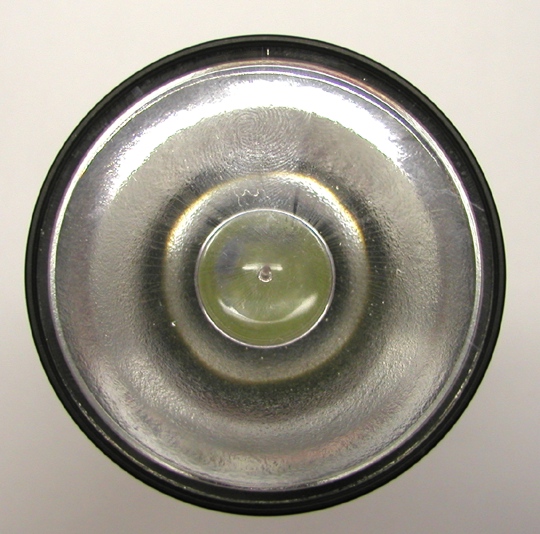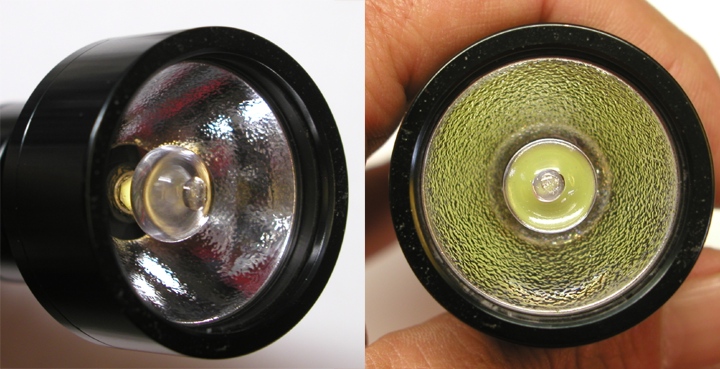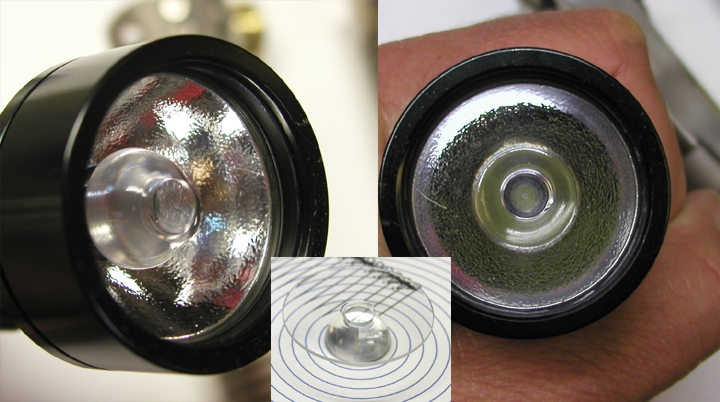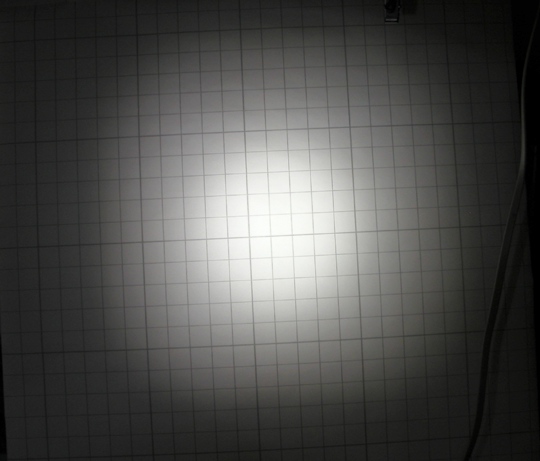I came up with a simple method of suspending an optical element in front of the LED within a reflector:


MORE INFO
I posted some lux measurements on the MORE INFO web page linked above. I will bring in the beam shots:


From left to right: first a stock 3" SF "t" without any additional optics. Next is the combo with 1/2 ball lens all the way out, contacting the flat lens. the 1/2 ball is then progressively moved towards the LED until in the last image on the right, you have little effect from the reflector and a wide flood is projected due to the position of the 1/2 ball.
Interestingly, with the 1/2 ball situated where it just keeps you from seeing the LED, regardless of off angle view, you get a good lux reading as well as a beam like the second in on the right where the normal direct flood or spill would usually be much wider in angle with much less intensity. This normal flood can barely be detected in the "stock" image on the far left.
Unfortunately, I kind of screwed up the lexan lens when I removed it. In retrospect, instead of using .040" tungsten rod for the "uni-strut" I should have used some .062 nitinol that I have sitting around. Finally a perfect application for it and I don't consider it. /ubbthreads/images/graemlins/grin.gif
With this combination strategy, a new door is open for photon management. Shallower and wider reflectors could be used with optic elements to keep most of the light closer to the center. Given a certain sized reflector, I assume a mathematical solution might exist where a particular lens size and position could be determined for a near overlap of reflected beam and refracted beam portions. The rear end of NX05's and the 30mm could be removed and allow for partial management of the photons by the lens and partial by the reflector.
As anyone knows using the plastic optics, TIR is really MIR (mostly internal reflection). What I like about this combination shown above is that there isn't any TIR as part of the scheme.
If the flat lens weren't damaged and if the 1/2 ball had AR coating on the flat side facing the LED, it would be interesting to see the effect this would have on the lux readings.


MORE INFO
I posted some lux measurements on the MORE INFO web page linked above. I will bring in the beam shots:


From left to right: first a stock 3" SF "t" without any additional optics. Next is the combo with 1/2 ball lens all the way out, contacting the flat lens. the 1/2 ball is then progressively moved towards the LED until in the last image on the right, you have little effect from the reflector and a wide flood is projected due to the position of the 1/2 ball.
Interestingly, with the 1/2 ball situated where it just keeps you from seeing the LED, regardless of off angle view, you get a good lux reading as well as a beam like the second in on the right where the normal direct flood or spill would usually be much wider in angle with much less intensity. This normal flood can barely be detected in the "stock" image on the far left.
Unfortunately, I kind of screwed up the lexan lens when I removed it. In retrospect, instead of using .040" tungsten rod for the "uni-strut" I should have used some .062 nitinol that I have sitting around. Finally a perfect application for it and I don't consider it. /ubbthreads/images/graemlins/grin.gif
With this combination strategy, a new door is open for photon management. Shallower and wider reflectors could be used with optic elements to keep most of the light closer to the center. Given a certain sized reflector, I assume a mathematical solution might exist where a particular lens size and position could be determined for a near overlap of reflected beam and refracted beam portions. The rear end of NX05's and the 30mm could be removed and allow for partial management of the photons by the lens and partial by the reflector.
As anyone knows using the plastic optics, TIR is really MIR (mostly internal reflection). What I like about this combination shown above is that there isn't any TIR as part of the scheme.
If the flat lens weren't damaged and if the 1/2 ball had AR coating on the flat side facing the LED, it would be interesting to see the effect this would have on the lux readings.










